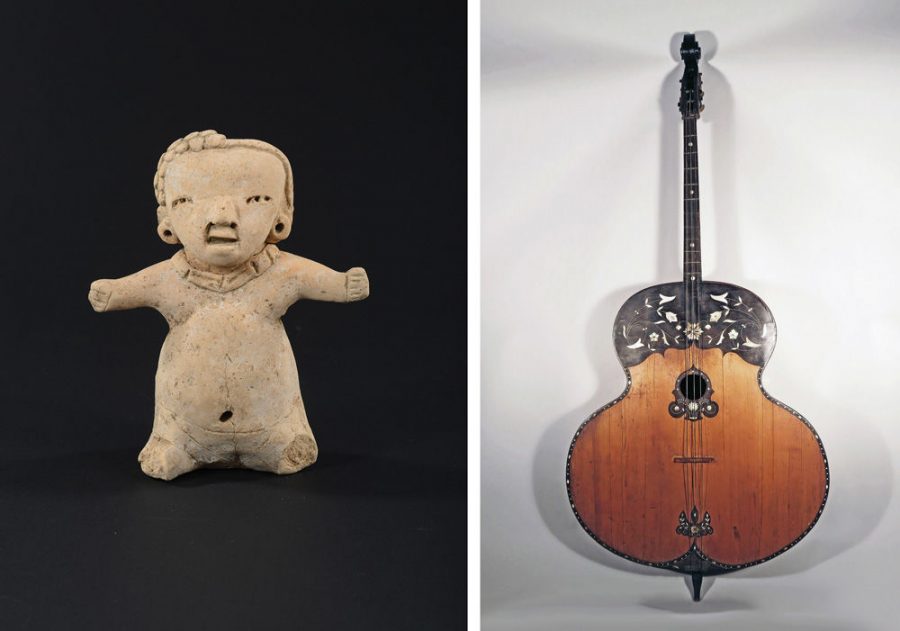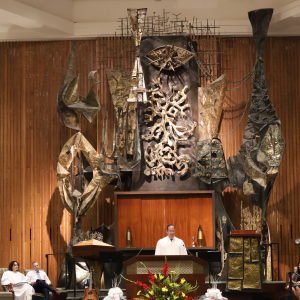Exploring the artistry of musical instruments
Published January 4, 2019
After seeing a couple of dazzling special exhibitions at the Metropolitan Museum of Art in New York, I walked over to the galleries of musical instruments. The collection includes approximately 5,000 examples from six continents and the Pacific Islands and are from 300 B.C. to the present. The galleries illustrate the development of musical instruments from all cultures and eras. The text panels said that the instruments may be understood in a number of ways: as art objects, as ethnographic record and as documents of the history of music performance. The galleries proved to be dazzling as well as what I’d originally come to see.
Just to give you an idea of what I saw, there were slit gongs from Africa, a pair of kettledrums from Hanover, Germany from 1779 and a 6-foot-7-inch tall contrabass saxophone.
I remembered visiting the Musical Instrument Museum, better known as MIM, in Phoenix years ago. MIM opened in 2010 and is the largest museum of its kind in the world. The collection of more than 15,000 musical instruments and associated objects includes examples from nearly 200 countries, representing every inhabited continent. Some larger countries such as Mexico, India, China, Russia, the United States and Brazil have multiple displays with subsections for different types of ethnic, folk and tribal music.
ADVERTISEMENT
The museum was founded by Robert J. Ulrich, former CEO and chairman of Target Corporation. An avid collector of African art and a world museum enthusiast, Ulrich and his friend, Marc Felix, originated the idea after a visit to the Musical Instrument Museum in Brussels, Belgium.
The Belgian museum was originally attached to the Royal Conservatory of Brussels, with the purpose of demonstrating early instruments to students. The museum itself was created in 1877 with a collection of 100 Indian instruments given to Belgian King Leopold II by Rajah Sourindro Mohun Tagore in 1876 and the collection of the celebrated Belgian Musicologist Francois-Joseph Fetis, purchased by the Belgian government in 1872 and put on deposit in the Conservatory, where Felix was the first director.
There are museums of musical instruments all over the world. Some are devoted to specific instruments and periods of time, such as the Museum of Musical Instruments in Milan, Italy. This museum exhibits over 700 musical instruments from the 15th to 20th centuries, with particular attention to Lombard instruments. The collection contains plucked instruments, Lombard and Cremonese violins, hunting horns, numerous wood instruments, pianos and some ancient organs and more.
ADVERTISEMENT
The National Museum of American History in Washington D.C. has a collection of music and musical instruments. The Museum’s music collections contain more than 5,000 instruments of American and European heritage. These include a quartet of 18th-century Stradivari stringed instruments, Tito Puente’s autographed timbales and the Yellow Cloud guitar that belonged to Prince, to name only a few.
And our own Sheldon Art Galleries in Grand Center is now the owner of a collection of musical instruments worth more than $2 million, donated by local music professor Aurelia Hartenberger. She spent more than 40 years accumulating 2,500 instruments from nearly every continent. Some are contemporary, others date back 3,000 years.
“The Hartenberger Collection is the perfect link between our Sheldon Art Galleries and the Sheldon Concert Hall — and we’re already showing parts of the collection in our Galleries and using them in education programs for young people,” said said former director of the Sheldon Arts Foundation Paul Reuter.
Olivia Lahs Gonzales, curator of the Sheldon Art Galleries, reminded me that an exhibition of musical instruments from the Balkans, India and Mexico is the first in a series that celebrates St. Louis’ immigrant communities. Highlights include a 3,000- year-old Olmec whistle and a 12th-century Hindu “Vamavarta” conch from India.
As usual, St. Louis is right on target with this unique array of world instruments. Check your calendar to put some exciting dates to see the revolving displays of these very special objects of art.
For more of Nancy Kranzberg’s commentary, listen to KWMU (90.7) St. Louis on the Air the first Friday of each month at approximately 12:50 p.m. She also hosts a weekly Arts Interview podcast for KDHX (88.1), available at artsinterview.kdhxtra.org.















